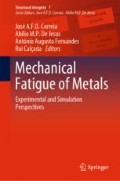Abstract
Design and qualification of load-bearing metal parts produced by the additive manufacturing technology is a critical issue. Such metal parts are complex in geometry with notches that are critical locations under fatigue loading. Notch surfaces are typically in the as-built state because post-fabrication surface finishing is not a viable approach in most applications. Here fatigue experiments using notched specimens produced according to different orientations with respect to build direction are presented and used to discuss the notch fatigue behavior of DMLS Ti6Al4V. Notch fatigue factors depend on the process itself and on fabrication details such as up-skin versus down-skin surface orientation, stair-stepping of the notch surface due to the layer-by-layer segmentation and intrinsic as-built surface roughness.
Access this chapter
Tax calculation will be finalised at checkout
Purchases are for personal use only
References
DebRoy T et al (2018) Additive manufacturing of metallic components—process, structure and properties. Prog Mater Sci 92:112–224
Kahlin M, Ansell H, Moverare JJ (2017) Fatigue behaviour of notched additive manufactured Ti6Al4V with as-built surfaces. Int J Fatigue 101:51–60
VDI-Guidline 3405 Part 3 Dec 2015, Additive manufacturing processes, rapid manufacturing—design rules for part production using laser sintering and laser beam melting (2015)
Nicoletto G (2017) Anisotropic high-cycle fatigue behavior of Ti-6Al-4V obtained by powder bed laser fusion. Int J Fatigue 94:255–262
Nicoletto G (2018) Directional and notch effects on the fatigue behavior of as-built DMLS Ti6Al4V. Int J Fatigue 106:124–131
Acknowledgements
The research was supported by the project Slovak VEGA grant No. 1/0685/2015. Specimen production by the company BEAM-IT, Fornovo Taro (Italy) (www.beam-it.eu) is gratefully acknowledged.
Author information
Authors and Affiliations
Corresponding author
Editor information
Editors and Affiliations
Rights and permissions
Copyright information
© 2019 Springer Nature Switzerland AG
About this paper
Cite this paper
Nicoletto, G., Konečná, R. (2019). Influence of Surface Orientation and Segmentation on the Notch Fatigue Behavior of as-Built DMLS Ti6Al4V. In: Correia, J., De Jesus, A., Fernandes, A., Calçada, R. (eds) Mechanical Fatigue of Metals. Structural Integrity, vol 7. Springer, Cham. https://doi.org/10.1007/978-3-030-13980-3_14
Download citation
DOI: https://doi.org/10.1007/978-3-030-13980-3_14
Published:
Publisher Name: Springer, Cham
Print ISBN: 978-3-030-13979-7
Online ISBN: 978-3-030-13980-3
eBook Packages: EngineeringEngineering (R0)

